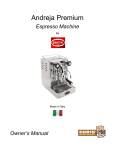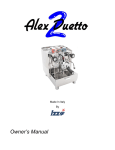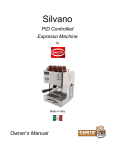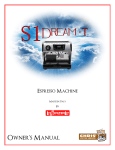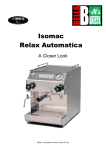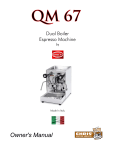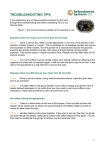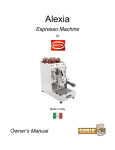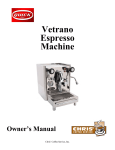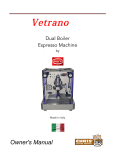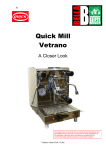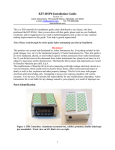Download Vetrano Espresso Machine Owner`s manual
Transcript
Vetrano Espresso Machine Owner’s Manual Vetrano Table Of Contents Diagrams..........................................................................................3 Introduction ......................................................................................4 First Time Set Up .............................................................................4 Before Each Use ..............................................................................5 Normal Operation.............................................................................5 Brewing Espresso ............................................................................6 Steaming Milk Basics. ......................................................................7 Steaming Milk Technique.................................................................8 Hot Water Wand Operation..............................................................8 Regular Maintenance .......................................................................9 Backflushing.....................................................................................9 Setting Pump Pressure ..................................................................10 Expansion Valve Adjustment .........................................................11 Setting Steam Pressure .................................................................12 Group Gasket And Shower Screen Replacement..........................13 Troubleshooting .............................................................................15 No Steam From Steam Wand ........................................................15 No Water From Water Wand..........................................................15 Not Heating ....................................................................................16 Espresso Coming Out Too Slow Or Not At All ...............................16 Espresso Coming Out Too Fast.....................................................16 Warranty.........................................................................................17 We Are Here To Help.....................................................................17 -2- Diagrams Vetrano 1. Steam Knob 2. Power Indicator Light 3. Steam Wand 4. Pressure Gauge 5. E61 Group Head 6. Main Power Switch 7. Cup Warming Tray 8. Heating Indicator Light 9. Hot Water Knob 10. Boiler Filling Indicator Light 11. Hot Water Wand 12. Brew Lever 13. Drip Tray 1. Single Portafilter 2. Double Portafilter 3. Cleaning Brush 4. Backflush Disc 5. Tamper/Coffee Scoop 1. Braided Water Line 2. Fiber Washer 3. John Guest Fitting -3- Introduction Vetrano First of all, thank you for your business! You are going to love your new Vetrano – it combines beauty, value, and great brewing for making the best espressos, cappuccinos, and lattes you’ve ever tasted! These instructions include hints that will help you get started quickly. First Time Set Up • Before connecting your machine to your water source, test your water for hardness using the provided test strips. Fill a glass with cold tap water; dip the tip of the test strip into the water for one second, then pull the strip out of the water and hold it horizontally for fifteen seconds. After fifteen seconds, compare the color of the strip to the chart on the side of the package to determine how many grains of hardness is in your tap water. Three grains or less of hardness is acceptable. Note: Should your water’s hardness level exceed three grains, then it is strongly recommended that a softener system be installed to prolong the life of your machine. • Included with the braided water line are two fiber washers. One washer is to be used in between the elbow connection of the braided line and where it attaches to the back bottom of the machine. The other washer is to be used if you will not be using the provided John Guest fitting. (No teflon tape needed) • Attach the braided water line to the back bottom of the machine using the provided fiber washer. Attach the other end to your water source using the provided John Guest fitting. The machine comes standard with a 3/8” John Guest fitting, but a 1/4” fitting can also be installed. To use the John Guest fitting the tubing needs to have a clean rounded cut using a tubing cutter or a sharp razor blade. Then insert the tubing into the John Guest fitting until it bottoms out. • If you are not going to be using the John Guest fitting then you will need to use the additional fiber washer and you will need to purchase a 3/8” male BSPP fitting. • After connecting both ends of the braided water line, turn on the water supply and verify there are no leaks. • Before plugging the machine in, verify the steam and hot water knobs are closed and the brew lever is in the down position. • Plug the machine in and turn the main power switch to the on position. • The boiler filling indicator light will illuminate and the pump will come on to start filling the boiler. The boiler should fill in approximately 60 seconds. If the pump has not turned off and finished filling after 60 seconds then turn the main power switch off and wait 5 minutes. -4- Vetrano • After waiting five minutes then turn the main power switch on again. The pump should come back on to continue filling the boiler. If the pump keeps running for more than 45-60 seconds again then unplug the machine and check to make sure that the water supply is turned on. • After the boiler has finished filling then place whichever portafilter you intend to use into the group head. Then lift the brew lever to start the pump and keep the lever up until water comes out of the portafilter and then lower the lever. • The heating indicator light will illuminate and the machine will start heating up. You will hear some gurgling noises and a small amount of steam and water will be discharged into the drip tray. This is normal to allow for the release of air and the expanding of water in the boiler and heat exchange. • The machine should reach temperature in approximately 15 minutes, but to make delicious espresso with thick rich crema it is necessary to allow the machine to be heated for 30-45 minutes with the portafilter kept in the grouphead. Before Each Use • Verify the steam and hot water valves are both closed and your brew lever is pointing straight down. • Place whichever portafilter you intend to use into the group. Turn the power switch on. Normal Operation • The top portion of the gauge is your boiler steam pressure. When the heating light turns off the boiler is up to presssure and should be around 1.2 bar. Once up to pressure the heating light will come on approximately once a minute to maintain the pressure in the boiler. Should you need to adjust the steam pressure please refer to the maintenance section of the owner’s manual. • The lower portion of the gauge is your pump pressure. When the pump is not engaged the gauge will show a reading which is the line pressure from your water supply and is normal. When you raise the brew lever then the pressure should go to 9 bar. This will vary based on your line pressure. Should your pressure be too low or too high please refer to the maintenance section of the owner’s manual for instructions on setting the pump pressure. • Periodically the pump and boiler fill light will come on to maintain the proper water level in the boiler, this is normal operation and no reason for concern. Brewing Espresso -5- Vetrano First let’s begin by explaining the three main variables of preparing great espresso. 1. Quantity of ground coffee 2. Tamp firmness 3. The grind The quantity of ground coffee. Loosely fill the basket slightly mounding over the top. Then lightly run your finger arched across the basket from left to right, right to left, front to back, and then lay your finger flat on the basket and go from back to front to remove any excess coffee. This technique helps fill any voids in the basket to help achieve an even extraction. Tamp firmness. After filling the basket with coffee then use your tamper to apply 30lbs of pressure evenly on the coffee bed. Then without applying any pressure lightly twist the tamper on the bed of coffee to “polish” the loose grounds on top. Then lock the portafilter firmly in the espresso machine and then raise the brew lever to start the extraction. When it has reached the desired level, lower the brew lever to stop the shot. It is very important to tamp consistently with the same pressure or your shot timing will vary. The last variable, the grind. Adjust your grind so that when you activate the pump, the flow of coffee coming out of the portafilter spout looks like the tapered tail of a mouse. It should take approximately 25 seconds for a 2 oz. double shot. If it is coming out quicker then the grind needs to be adjusted finer, if it is coming out slower or not at all then the grind should be adjusted coarser. The grind particle size should look in between powder and salt. Not as fine as powder, but not as coarse as salt. Tip: Get into the habit of disposing of the spent grounds immediately after brewing espresso. After disposing of the grounds, return the portafilter to the group and activate the brew button for a few seconds to rinse away excess oils and loose grounds. By regularly following this procedure, you will greatly reduce the tar-like buildup on the dispersion screen that occurs if you allow coffee oils to dry and bake on the hot group. A cleaning brush has also been included to clean the group screen and gasket. Note: If the machine has been sitting for awhile then it may be necessary to do a “cooling flush” This is done to bring the water temperature down to the proper brew temperature or the shots may come out bitter and over extracted. To do a cooling flush with no portafilter in place raise the brew lever and observe the water coming out of the grouphead. When the water stops spitting and sputtering and comes out in a steady stream then you can lower the brew lever and the cooling flush is complete. If you are doing multiple shots in a row then you should not need to do a cooling flush. Steaming Milk - Basics -6- Vetrano First, let’s talk about some of the things you need to learn in order to become ‘barista-like’ in your techniques. Milk – Whole milk works best to steam, both in technique and in flavor! Lower fat milks contain mostly water which will not foam well and will be almost tasteless when steamed. After all your hard work you will be left with a less than desirable tasting beverage. Milk – Your whole milk needs to be as cold as possible to ensure the creamiest, sweetest, and best tasting micro-foam. Once the milk has reached a temperature between 150-160 degrees, you must stop the process. The longer amount of time you have with the cold milk gives you that extra time to continue making the milk creamy and sweet tasting. Milk heated above 160 degrees will be burnt and taste terrible. Frothing Pitcher – Keeping your stainless steel pitcher in the freezer is another tip which helps keep the milk its’ coldest. The size of your pitcher is relative to the size and number of drinks you will be preparing at the time. Amount of Milk – Too little milk in your frothing pitcher will cause splashing when you turn on the steam arm; too much milk will cause overflow and make a huge mess. The pitcher must be filled between 1/3 to 1/2 full to have the maximum capacity for properly steaming milk. If your pitcher has a spout, fill it to half an inch below where the spout starts. Stretching the milk – Refers to the initial heating of the milk and the forceful introduction of air into the milk (using the steam wand pressure) – stretching the consistency of the milk. Stretching continues until the milk reaches an approximate temperature of 100 degrees (body temperature). Texturizing the milk – Refers to the next phase of frothing whereby the steam wand is submerged in the milk and the pressure continues to roll the milk. The process breaks down the large air bubbles into tiny air bubbles which then creates the smooth and creamy texture that is most desirable. Steaming Milk - Technique As you face your espresso machine, point the steam arm over your drip tray and open up the steam valve in order to purge out any unwanted water that may have collected inside the wand due to condensation – you do not want that added to your delicious beverage! Next, position the steam arm so it is facing directly toward you and slightly angle it 45 degrees from the base. -7- Vetrano Holding your half-filled steam pitcher with the handle facing you, submerge the tip of the steam wand approximately an inch below the surface of the cold milk. Your pitcher bottom should be parallel with the countertop. The steam arm should gently rest in the spout of the steam pitcher. Now slightly tilt the pitcher left, keeping the arm away from the side of the pitcher. Open the steam valve completely and position the pitcher so the tip is just below the surface of the milk. This action creates the ‘stretching’ of the milk – in other words, adding air to the milk. When done properly, the sound you hear at this point resembles ‘sucking’. You continue this until the milk reaches an approximate temperature of 100 degrees. After your milk has reached this ‘body temperature’, submerge the tip of the steam arm approximately one inch below the surface of the milk. This process continues to roll the milk over itself again and again – breaking the large air bubbles into tiny air bubbles – resulting in a new, creamy and sweeter, texture of the milk. When your milk has reached approximately 155 degrees – turn the steam valve off. Helpful Tips and Information • When turning the steam valve off, always keep the tip under the surface of the milk for approximately 3 seconds. If you pull it out too soon, you will destroy the nice velvety microfoam. • After removing the steam wand from the milk, position it over the drip tray and then open the steam valve for 1-2 seconds to clean out any trapped milk inside the tip and then wipe it down with a damp cloth. • While texturizing the milk, if you lower the tip too far into the milk you create turbulence rather than rolling. Turbulence will not make micro-foam. • If there are a few bubbles in the milk after you have finished, wait 5-10 seconds to allow all the remaining bubbles to surface, then simply tap the edge of the pitcher on the counter and swirl the milk slightly and they will disappear. • Be sure to keep your steamed milk moving/swirling until you are ready to pour since milk has a natural tendency to separate. Hot Water Wand Operation • The hot water wand uses the steam pressure to push the hot water out of the boiler so the machine must be up to temperature before it is able to give any hot water. • To use the hot water wand, position the cup or pitcher under the wand and then open the hot water knob. Once the water has reached the desired level then close the hot water knob. • It is not recommended to remove more than 6 oz. of water at any one time until the machine has had time to refill the boiler. Failure to do so may cause damage to the heating element. -8- Vetrano Warning: The water from the hot water wand is approximately 250° and exits the boiler under force due to the steam pressure. Extreme caution is advised when using the wand or injury may occur. Regular Maintenance Backflushing is a vital maintenance procedure you must follow to help keep your machine running flawlessly for years to come. There are two types of backflushing; one with plain water, and the other with espresso machine cleaner. Plain water backflushing should be done at least once a week, however if you are so inclined, feel free to backflush with plain water as often as you like. It won't harm the machine and keeps the dispersion screen clean. To backflush, you use the portafilter’s blank insert (the round stainless steel disk without holes). To remove your single or double portafilter basket, use the blank portafilter insert. Turn it upside down and use its edge to pry the basket out of one of your portafilters. (If you always make double espressos, you may choose to keep the blank portafilter insert in your other portafilter so you always have one ready.) Next, place the blank insert into the portafilter and slap it hard with the palm of your hand to secure it in place. To perform a plain water backflush, place the portafilter into the group and snug it firmly. Next, raise the brew lever all the way up for 15 seconds, and then lower it all the way down. Water will forcefully discharge out of the bottom of the group into the drip tray; this is normal. Repeat three to five times. Backflushing with espresso machine cleaner is the same procedure as above with a few minor differences. The first difference is backflushing with espresso machine cleaner only needs to be done approximately once a month or every 35-50 espressos. we don't recommend backflushing with cleaner more often than once every three weeks since overuse will remove oils that lubricate the brew lever and valves. You can water backflush as often as you prefer. To begin, place 1/4 of a teaspoon of espresso machine cleaner into the blank portafilter insert, then lock the portafilter into the group. Now follow the same procedure as above until the cleaner is dissolved and the water runs clear (about 5-10 flushes). Remove the portafilter from the group and rinse thoroughly. Then take a damp cloth and wipe the underside of the group. After you have finished this procedure, we recommend you pull a shot of espresso and dispose of it to cure the group. You're finished and ready for another month of espresso. Note: We only recommend using either Puro Café or Urnex Full Circle Espresso Machine Wash because they are specially formulated for this purpose. The use of other cleaners may affect the performance of your machine and could even damage it. -9- Vetrano Setting Pump(brew) Pressure Warning: This adjustment requires removing the shell and making an adjustment with the machine plugged in so it is very important to exercise extreme caution. Failure to do so may cause injury, and or electrical shock. We assume no liability for failure to follow this warning. • Unplug the machine from the outlet and then remove the outer body panels. • Plug the machine back into the outlet and then turn the power switch on. • Locate the pump in the back right corner of the machine. • Loosen the lock nut labeled “A” with an adjustable wrench. • Raise the brew lever and then turn the adjustment screw labeled “B” Turning clockwise will increase the pressure, counter clockwise to decrease the pressure. Recommend setting to 9 bar using the lower pump gauge as reference. • After setting the pressure, lower the brew lever and then tighten the locknut labeled “A” • Turn the power switch off and then unplug the machine from the outlet before putting the outer body panels back on. Note: After adjusting the pump pressure then you may also need to adjust your grinder. Expansion Valve Adjustment Warning: This adjustment requires removing the shell and making an adjustment with the machine plugged in so it is very important to exercise extreme caution. Failure to do so may cause injury, and or electrical shock. We assume no liability for failure to follow this warning. - 10 - Vetrano • The expansion valve is used to allow for the expansion of heated water in the heat exchange. This water is discharged into the drip tray via a black plastic spout. During heat up it is normal for the black plastic spout to discharge some steam and hot water into the drip tray. • Before making an adjustment the machine should be up to operating temperature. • After the machine is up to temperature follow the instructions for setting the pump pressure and raise the pump pressure to 12.5 bar. • Install the backflush disc into the portafilter and then lock the portafilter into the group head. • Remove the drip tray cover and then raise the brew lever. Use a 12mm or adjustable wrench to adjust the expansion valve adjustment nut. • With the pump running adjust the expansion valve so the black plastic spout in the drip tray just starts to drip. Turning clockwise will slow the drip, counter clockwise to increase. • Be sure the attached silicone hose does not get twisted, straighten out if necessary. • After adjusting the expansion valve then adjust the pump pressure back down to 9 bar. Note: If the expansion valve continues to drip at 9 bar after adjustment then the rubber seat inside the valve should be replaced. Setting Steam Pressure - 11 - Vetrano Warning: This adjustment requires removing the shell and making an adjustment with the machine plugged in so it is very important to exercise extreme caution. Failure to do so may cause injury, and or electrical shock. We assume no liability for failure to follow this warning. • It is only necessary to remove the top of the machine to adjust the steam pressure. • Before making an adjustment the machine should be up to temperature. • Remove the yellow cap that is covering the pressure adjustment screw. • Using a flat blade screwdriver, turn the adjustment screw clockwise to increase the pressure, counter clockwise to decrease. • Only make a 1/4 turn adjustment at a time and then open the steam valve for 2-3 seconds and then close it to get the heater to cycle on. You want to adjust the pressure stat so that the heater light turns off at about 1.2-1.3 bar. When adjusted properly the heater should come on at around 1 bar and then turn off around 1.3 bar. • You may have to repeat this procedure a few times to get the pressure set properly. • You may set the steam pressure lower if you desire, but you will not have as much steam capacity and the recovery time will be longer. Recommended setting is 1.2-1.3 bar. Warning: Do NOT set the steam pressure above 1.5 bar. Doing so may cause the pressure relief valve on the boiler to open up and release the steam from the boiler. Any damage caused for failure to follow this warning will not be covered under warranty. Group Gasket And Shower Screen Replacement • • The group gasket is a black rubber gasket that makes the seal between the portafilter and the group head. We recommend replacing the gasket on a yearly basis. The Vetrano uses an E61 8.5mm gasket. Replacing the group gasket requires the removal of the shower screen as well so we also recommend replacing the shower screen at the same time. - 12 - Vetrano • Before replacing the group gasket and shower screen the machine should be turned off and cooled down so that the grouphead is cool to the touch. Gasket and Screen Removal • There are two ways to remove the group gasket and shower screen depending on how old they are. If you replace the gasket yearly then the first method shown is recommended. If the gasket is older and dried out then the second method shown will be necessary. Method 1 In the picture to the right shows an indent that goes around the perimeter of the screen. Insert either a flat blade screwdriver or a spoon into the indent and then carefully pry the gasket and screen down. You may have to do this on a few spots to remove them. Method 2 If the gasket and screen will not come out using the method above then you will need a scratch awl or ice pick to remove them. Using the awl or pick, deeply pierce the gasket and then pry it down. If the gasket is old and dried out then it will break apart and come out in pieces. Repeat until all remnants of the old gasket are removed. Cleaning The Group • Before installing the new gasket and screen it is very important to clean the group head. Make up a solution of hot water and backflushing cleanser. Using the provided cleaning brush and cleanser, clean the group head and be sure the groove that the gasket sits in is completely free of any residual gasket material and coffee grounds or the new gasket will not seat properly. - 13 - Vetrano Gasket And Screen Installation Step 1 With the writing/beveled side of the gasket facing up insert the screen into the gasket as shown to the right. It is also recommended to use a little bit of food grade lubricant around the perimeter of the gasket to make installation easier. Step 2 Remove the insert basket from one of your portafilters and then insert the screen and gasket into the portafilter as shown to the right. Step 3 With the gasket and screen in the portafilter, press the portafilter into the group head. Apply equal pressure on the portafilter so the gasket goes in evenly. Once the gasket is up far enough then lock the portafilter into the group head and turn as far right as possible. Then remove the portafilter and re-install the insert basket and then work the gasket up furthur into the grouphead using the portafilter with the basket installed. If you are having trouble then remove the portafilter and press the screen up furthur by hand and then try using the portafilter again. Troubleshooting - 14 - Vetrano No Steam From Steam Wand • Make sure the machine has been turned on for at least 15 minutes. • Check the upper portion of the gauge for steam pressure. Pressure should be about 1.2 bar. If the gauge is at zero then refer to the “Not Heating” section of the troubleshooting manual. If pressure is good then continue with steps below. • Check the steam tip for a blockage. Clean steam tip holes with a paper clip. • Check the steam wand for a blockage by unscrewing the steam tip from the wand. Check the inside of the steam tip for dried up milk and then make sure the white teflon tube in the steam wand is also free of dried up milk. • Check the steam knob for proper operation. Remove the end cap on the end of the steam knob. Check to make sure that the c-clip shown in the picture is attached. No Water From Hot Water Wand • Make sure the machine has been turned on for at least 15 minutes. • Check the upper portion of the gauge for steam pressure. Pressure should be about 1.2 bar. If the gauge is at zero then refer to the “Not Heating” section of the troubleshooting manual. If pressure is good then continue with steps below. • Check the hot water knob for proper operation. Remove the end cap on the end of the hot water knob. Check to make sure that the c-clip shown in the picture above is attached. Note: If the steam gauge is showing normal pressure, but then when you open the steam or hot water knobs the pressure immediately drops to zero then heats normally afterwards that is called a vapor lock. This is caused by a sticking vacuum breaker valve not allowing the air pressure to escape the boiler during heat up. - 15 - Vetrano Not Heating • Verify the machine is plugged into the outlet and the outlet has power. Verify the power switch is in the “on” position. • Make sure the water is turned on to the machine. If the water was turned off, then turn the power switch off, unplug the machine and then wait 5 seconds and then plug the machine back in and turn the power switch on. • Check the resettable hi-limit switch on the boiler. Unplug the machine from the outlet and remove the top of the machine. Locate the resettable hi-limit switch on top of the boiler shown in the picture to the right. Press the small center button down firmly to reset. Espresso Coming Out Too Slow Or Not At All • Activate the brew lever and check the pump pressure. Recommended setting is 9 bar. Adjust pump pressure if necessary. • If pump pressure is good then try adjusting grind coarser. • Be sure the insert basket is not over filled with coffee and you are tamping with no more than 30lbs of pressure. Espresso Coming Out Too Fast • Activate the brew lever and check the pump pressure. Recommended setting is 9 bar. Adjust pump pressure if necessary. • If pump pressure is good then try adjusting grind finer. • Be sure the insert basket is filled with the proper amount of coffee and you are tamping with 30lbs of pressure. - 16 - Vetrano Warranty The Vetrano comes with a 1 year warranty starting from the original date of purchase to protect against defects in materials or workmanship. The warranty is void if the product has been damaged by abuse, neglect, or modification. We Are Here To Help Enjoy your new espresso machine and remember, should you have any questions, contact our staff through phone or email. Please remember: Save the shipping carton and all the packing material that came with your machine. This is very important should you need to return your machine to us. If you do need to send your machine back for any reason, you must first call our service department and obtain a Return Authorization number prior to shipping. Be sure to insure your machine and pack it securely. We can’t be responsible for any damage that might occur while in transit to us. Properly packing your machine with the original carton and packing material minimizes this possibility. Should it be necessary for you to file a damage claim with the shipper, we will of course be happy to assist you with the required forms. Thank you again for your business. - 17 -

















